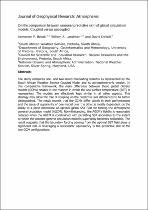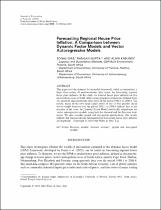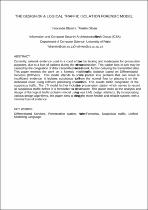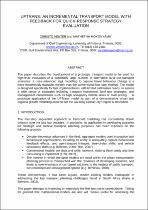 ResearchSpace
ResearchSpace
On the comparison between seasonal predictive skill of global circulation models: Coupled versus uncoupled
JavaScript is disabled for your browser. Some features of this site may not work without it.
- ResearchSpace
- →
- Research Publications/Outputs
- →
- Journal Articles
- →
- View Item
| dc.contributor.author |
Beraki, Asmerom F

|
|
| dc.contributor.author |
Landman, WA

|
|
| dc.contributor.author |
DeWitt, D

|
|
| dc.date.accessioned | 2016-05-16T10:22:38Z | |
| dc.date.available | 2016-05-16T10:22:38Z | |
| dc.date.issued | 2015-11 | |
| dc.identifier.citation | Beraki, A.F., Landman, WA and DeWitt, D. 2015. On the comparison between seasonal predictive skill of global circulation models: Coupled versus uncoupled. In: Journal of Geophysical Research: Atmospheres, 120(21), pp 11151-11172 | en_US |
| dc.identifier.issn | 0148-0227 | |
| dc.identifier.uri | http://onlinelibrary.wiley.com/doi/10.1002/2015JD023839/full | |
| dc.identifier.uri | http://hdl.handle.net/10204/8549 | |
| dc.description | Copyright: 2015 American Geophysical Union Wiley. Due to copyright restrictions, the attached PDF file only contains the abstract of the full text item. For access to the full text item, please consult the publisher's website | en_US |
| dc.description.abstract | The study compares one- and two-tiered forecasting systems as represented by the South African Weather Service Coupled Model and its atmosphere-only version. In this comparative framework, the main difference between these global climate models (GCMs) resides in the manner in which the sea surface temperature (SST) is represented. The models are effectively kept similar in all other aspects. This strategy may allow the role of coupling on the predictive skill differences to be better distinguished. The result reveals that the GCMs differ widely in their performances and the issue of superiority of one model over the other is mostly dependent on the ability to a priori determine an optimal global SST field for forcing the atmospheric general circulation model (AGCM). Notwithstanding, the AGCM’s fidelity is reasonably reduced when the AGCM is constrained with persisting SST anomalies to the extent to which the coupled general circulation model’s superiority becomes noticeable. The result suggests that the boundary forcing coming from the optimal SST field plays a significant role in leveraging a reasonable equivalency in the predictive skill of the two GCM configurations. | en_US |
| dc.language.iso | en | en_US |
| dc.publisher | American Geophysical Union Wiley | en_US |
| dc.relation.ispartofseries | Workflow;15930 | |
| dc.subject | Atmospheric general circulation model | en_US |
| dc.subject | Climatological | en_US |
| dc.subject | Coupled model | en_US |
| dc.subject | Global climate models | en_US |
| dc.subject | Sea surface temperature | en_US |
| dc.subject | Seasonal forecasting | en_US |
| dc.subject | Temporal differences | en_US |
| dc.subject | Uncoupled models | en_US |
| dc.title | On the comparison between seasonal predictive skill of global circulation models: Coupled versus uncoupled | en_US |
| dc.type | Article | en_US |
| dc.identifier.apacitation | Beraki, A. F., Landman, W., & DeWitt, D. (2015). On the comparison between seasonal predictive skill of global circulation models: Coupled versus uncoupled. http://hdl.handle.net/10204/8549 | en_ZA |
| dc.identifier.chicagocitation | Beraki, Asmerom F, WA Landman, and D DeWitt "On the comparison between seasonal predictive skill of global circulation models: Coupled versus uncoupled." (2015) http://hdl.handle.net/10204/8549 | en_ZA |
| dc.identifier.vancouvercitation | Beraki AF, Landman W, DeWitt D. On the comparison between seasonal predictive skill of global circulation models: Coupled versus uncoupled. 2015; http://hdl.handle.net/10204/8549. | en_ZA |
| dc.identifier.ris | TY - Article AU - Beraki, Asmerom F AU - Landman, WA AU - DeWitt, D AB - The study compares one- and two-tiered forecasting systems as represented by the South African Weather Service Coupled Model and its atmosphere-only version. In this comparative framework, the main difference between these global climate models (GCMs) resides in the manner in which the sea surface temperature (SST) is represented. The models are effectively kept similar in all other aspects. This strategy may allow the role of coupling on the predictive skill differences to be better distinguished. The result reveals that the GCMs differ widely in their performances and the issue of superiority of one model over the other is mostly dependent on the ability to a priori determine an optimal global SST field for forcing the atmospheric general circulation model (AGCM). Notwithstanding, the AGCM’s fidelity is reasonably reduced when the AGCM is constrained with persisting SST anomalies to the extent to which the coupled general circulation model’s superiority becomes noticeable. The result suggests that the boundary forcing coming from the optimal SST field plays a significant role in leveraging a reasonable equivalency in the predictive skill of the two GCM configurations. DA - 2015-11 DB - ResearchSpace DP - CSIR KW - Atmospheric general circulation model KW - Climatological KW - Coupled model KW - Global climate models KW - Sea surface temperature KW - Seasonal forecasting KW - Temporal differences KW - Uncoupled models LK - https://researchspace.csir.co.za PY - 2015 SM - 0148-0227 T1 - On the comparison between seasonal predictive skill of global circulation models: Coupled versus uncoupled TI - On the comparison between seasonal predictive skill of global circulation models: Coupled versus uncoupled UR - http://hdl.handle.net/10204/8549 ER - | en_ZA |








